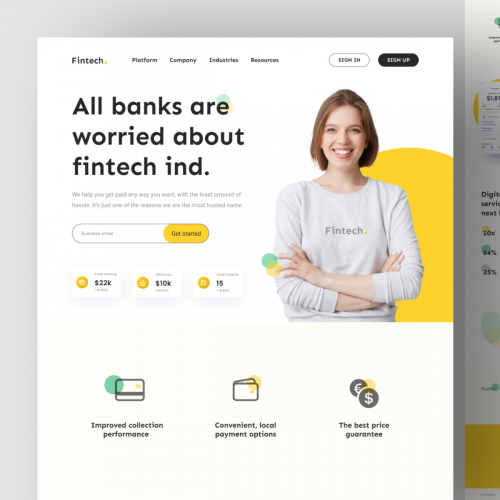High-Converting Website Design Solutions for Enhanced Engagement
High-Converting Website Design Solutions for Enhanced Engagement
Blog Article
Top Tips for Producing an Impactful Internet Site Design That Converts
To achieve this, one need to consider a selection of elements, consisting of comprehending the target audience, focusing on individual experience, and maximizing for mobile platforms. The critical use of engaging call-to-actions and a well-defined aesthetic pecking order plays an important duty in directing customers with their trip.

Understand Your Target Audience
Recognizing your target audience is essential to reliable site style, as it prepares for creating an appealing individual experience. Recognizing who your users are, including their demographics, preferences, and habits, enables designers to customize the website's web content, format, and functionality to satisfy specific needs.
Carrying out detailed market research is important in this procedure. Studies, meetings, and analytics can give important insights into individual assumptions and pain points. By assembling this information, developers can create user personas that represent various sectors of the target market, making certain that design choices are educated and appropriate.
In addition, understanding the target audience helps in selecting ideal layout aspects such as color plans, typography, and images that resonate with individuals. A website that talks straight to its target market promotes a sense of link and depend on, motivating longer check outs and higher conversion prices.
Eventually, a user-centered method to website style not only enhances customer contentment yet likewise supports service objectives by driving involvement and loyalty. By focusing on the requirements and preferences of the target market, a web site can efficiently offer its function and achieve wanted results.
Prioritize Individual Experience
To enhance the total performance of a web site, focusing on individual experience (UX) is vital (Website Design). A properly designed UX guarantees that visitors can navigate the website easily, locate details swiftly, and engage with content meaningfully. This causes raised customer fulfillment and higher conversion prices
Begin by applying user-friendly navigating. Menus must be logically structured, allowing customers to situate key locations of the site with marginal effort. Uniformity in design elements, such as color schemes and typefaces, fosters knowledge, which is critical for keeping individual engagement.
In addition, consider the filling speed of your internet site. A delay of simply a few secs can lead to substantial drop-offs, as users are much less likely to wait on a slow-loading page. Enhancing photos and enhancing code can boost efficiency and preserve visitors.
By prioritizing customer experience, you not only develop a much more enjoyable setting for visitors however also reinforce your brand's reputation. Eventually, an emphasis on UX is an investment in the long-term success of your web site.
Maximize for Mobile Gadgets
Maximizing for mobile phones is important in today's electronic landscape, where a raising number of customers access web sites through mobile phones and tablet computers. A mobile-friendly design not only boosts customer experience but additionally plays a considerable duty in boosting internet search engine positions. To accomplish this, it is crucial to adopt a responsive style that instantly adapts to different display dimensions and orientations.

Loading speed is an additional critical element; mobile users are usually much less individual and expect fast access to details. Maximize photos and utilize internet browser caching to enhance efficiency. Examination your web site on numerous gadgets and display resolutions to determine and correct any kind of prospective use problems. By prioritizing mobile optimization, you make certain that your site continues to be affordable and effectively involves a broader target market.
Usage Engaging Call-to-Actions
A site's performance typically depends upon its capability to guide visitors towards desired actions, making engaging call-to-actions (CTAs) crucial parts of style. CTAs act as the pivotal factors that route users to involve with the website, whether that suggests making an acquisition, registering for an e-newsletter, or downloading a source.
To produce effective CTAs, clearness is paramount. Usage concise language that clearly communicates the action you want the customer to take. Expressions such as "Begin," "Sign Up Free," or "Store Now" not only communicate necessity but likewise remove ambiguity. The placement of CTAs is just as essential; they should be purposefully positioned throughout the webpage to ensure they are quickly noticeable, especially in high-traffic locations.
Furthermore, think about making use of directional signs, such as arrowheads or pictures, to assist customers toward these buttons. By concentrating on these elements, services can significantly boost user interaction, driving conversions and inevitably accomplishing their web site's goals.
Focus on Visual Power Structure
Effective site layout depends heavily on a well-structured visual pecking order that guides users with content perfectly. By arranging elements in a way that focuses on details, developers can enhance individual experience and assist in decision-making. This includes using size, shade, comparison, and spacing tactically to draw interest to one of the most important components of a page.
The usage of bigger typefaces for headings and subheadings develops a clear difference in between various sections, enabling individuals to check material effortlessly. In addition, using contrasting shades for buttons and calls-to-action can record individual focus and urge interaction. Whitespace is one blog more crucial element; it prevents clutter and enables individuals to concentrate on essential messages without interruptions.
Images and graphics should complement the text while also adhering to the recognized hierarchy, reinforcing the total message (Website Design). Consistency in layout elements, such as color design and typography, more reinforces the aesthetic hierarchy, making navigation intuitive

Conclusion
In verdict, effective internet site design requires a thorough understanding of the target market, prioritization of user experience, and mobile optimization. The calculated usage of compelling call-to-actions and a well-defined aesthetic pecking order further enhances individual engagement. By implementing these principles, sites can accomplish higher conversion rates, guaranteeing that style components not just bring in visitors yet also facilitate smooth navigating and interaction. Eventually, a well-executed site layout functions as a crucial component in driving customer actions and attaining service objectives.
Report this page